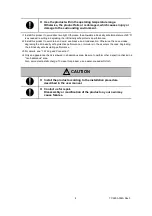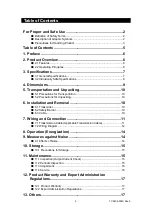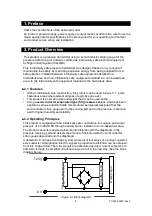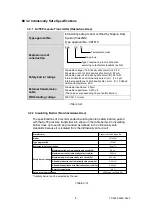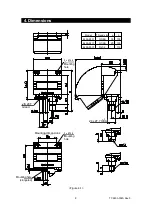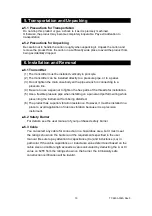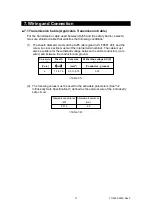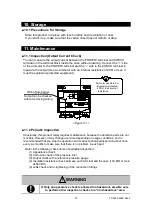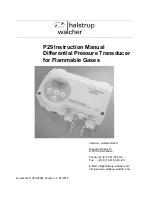
8
TY-KJ55-002A Rev.3
■
3.2 Intrinsically Safe Specifications
3.2.1 KJ55 Pressure Transmitter (Hazardous Area)
Type approval No.
Intrinsically safe product certified by Nippon Kaiji
Kyokai (ClassNK)
Type approval No.: 08T610
Explosion-proof
construction
Safety barrier ratings
Allowable voltage of intrinsically safe circuit (Ui): 28 V
Allowable current of intrinsically safe circuit (li): 93 mA
Allowable power of intrinsically safe circuit (Pi): 651 mW
Internal inductance of intrinsically safe circuit
(Li): 9 μH
Internal capacitance of intrinsically safe circuit
(Ci): 0.065 μF
Ambient temperature: 60 ̊
C
External transmission
cable
Allowable inductance: 2.5 mH
Allowable capacitance: 0.015 μF
(The values vary depending on your safety barrier.)
Withstanding voltage
500 VAC, 1 minute
3.2.2 Insulating Barrier (Non-hazardous Area)
The specifications of a recommended insulating barrier (safety barrier) paired
with the KJ55 pressure transmitter are shown in the table below. An insulating
barrier does not need to be grounded as defined in the intrinsically safe
standards because it is isolated from the intrinsically safe circuit.
* A safety barrier can be selected by the user.
<Table 3-2>
<Table 3-3>
Exia
II C
T5
Temperature class
Gas group
Type of explosion-proof construction
according to technical standards (by NK)
Cooper Industries Japan K.K.
MTL5541
12T607
Exia II C
Maximum voltage of intrinsically safe circuit (Uo)
28.0 V
Maximum current of intrinsically safe circuit (lo)
93.0 mA
Maximum power of intrinsically safe circuit (Po)
650 mW
Allowable inductance of intrinsically safe circuit (Lo)
3.05 mH
Allowable capacitance of intrinsically safe circuit (Co)
0.083 μF
Ambient temperature
60 °C
450 Ω max. (at 20mA DC)
Safety barrier ratings
Manufacturer
Model
Type approval No.
Explosion-proof construction
Safety area load resistance




